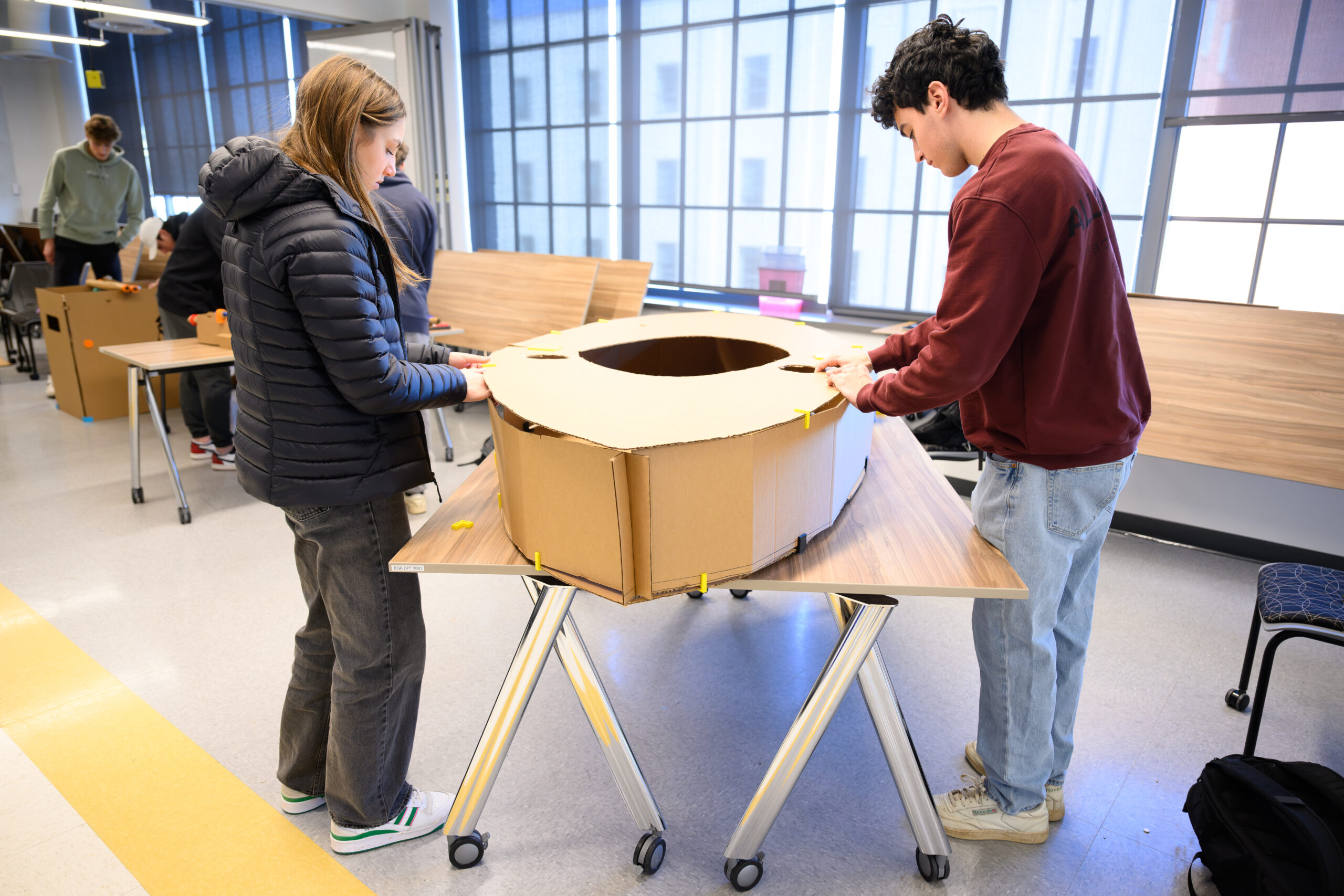Turning cardboard and 3D printed objects into foosball tables and kayaks
Engineering students meet the fall design challenge

Inside a classroom at Wake Downtown, engineering students arrived early to put the finishing touches on their cardboard creations. They were preparing to demonstrate their projects during the Fall 2024 Cardboard Showcase. It’s part of the Engineering 111 class that provides students with an introduction to the field.
“These students had half of a semester to work on a design for a piece of cardboard furniture,” said Tricia Clayton, associate professor of engineering at Wake Forest. “Every semester, the theme changes, and this year’s theme, which the students chose, is recreational items. We have different interpretations of what that looks like.”

From a children’s slide and poolside chair to a roulette table, students filled the room with small and large cardboard masterpieces. They were only allowed to use cardboard for construction. No adhesive or tape was permitted. Each project also had to include at least one 3D-printed item.
“Wow! Did you see that? It really works,” said first-year student Hunter Gregory. “We love foosball and making this table game with cardboard was challenging, especially the rods. We designed colorful plastic rings to use as fasteners using CAD and then printed them in the lab. This made our foosball rods more functional.”
“We made a few mistakes, and we had to figure out how to fix those mistakes on the fly,” added sophomore Jack Waldner. “There was lots of trial and error. All of us were expecting it to look cool but just seeing it here now and how it works; we are all so proud. It’s one thing to see it on paper but it’s another thing to see it in person in front of you.”
Thinking outside of the box
Students also had other design constraints for the project. Those included being able to fit their recreational item in a 1-meter-by-1-meter-by-1 meter box for storage purposes; it had to be transportable and recyclable.

Across the room, two students entered a large box and took a seat inside to demonstrate their Jurassic Park arcade game. It’s outfitted with a 3D-printed plastic steering wheel, sliding door for darkness and a screen made with a laser cutter that depicts dinosaurs in a tropical environment.
“Figuring out the laser cutter took us so many tries,” said Abby Ondos, a first-year student interested in environmental engineering from Pittsburgh. “Sometimes it would be too strong, so it would cut everything out and fall through. We had to do it I think four times and find the perfect amount of strength. It’s exciting to see all the design skills that we learned throughout the semester come together like this.”
“The hardest part was just trying to figure out how all the components fit together,” added Isabella (Mia) Rodriguez, a sophomore from Miami. “We also had to consider accessibility factors. It had to be certain heights to fit the tallest and the shortest person in the classroom, so we measured different heights of our classmates and took their arm measurements to make our arcade game user friendly for a variety of people.”
A holistic approach to engineering
As part of the Engineering 111 course, students also got to tour WestRock facility in Winston-Salem, which manufactures and distributes containerboard and paperboard products. The company, which focuses on using recycled materials, donated the cardboard for the Engineering 111 Cardboard Showcase.
Near a corner in the classroom, a lot of activity took place as visitors tried their hand at a game of corn hole and ski ball.
“The balls are made of paper, and everything here is sustainable, which is important,” said junior Andre Hodge. “It’s something that can sometimes get overlooked in a design and we worked hard to get it right.”

Designing the rounded parts of a kayak proved to be quite challenging for freshman Jake Lyon and his fellow team classmates. But the end result was a success.
“We started in small steps; brainstorming ideas and my favorite part was the collaboration with my classmates and then seeing this idea on paper become a reality,” said Lyon. “I can’t wait to build more down the road.”
This year, nearly 50 students participated in the fall Cardboard Showcase. Michael Gross, chair of the Wake Forest Department of Engineering, said the class is part of a holistic approach the University uses to create and train well-rounded engineers beyond just the technical skills.
“If you look at everything that engineers have to do in the real world, engineering is a liberal art in and of itself.”
Michael Gross, engineering chair and professor
“Our engineering curriculum is designed to be very hands-on and get students thinking about real-world applications, the impacts to society, the environment as well as cultural impacts. They also have to consider ethical implications and decision making,” said Gross.
For sophomore Akram Kawuma, his experience in the course has given him a new set of tools to support his career aspirations.
“Just coming together to solve a problem, it’s different from math or science or English where there seems to be a specific answer for everything,” he said. “Engineering is so interactive, and engineering to me is a class about creativity that lets you run on your own free will. We had to do that with this project. This class opened my eyes to so many possibilities and how engineering can make a difference in our communities and all around us.”
Categories: Entrepreneurship & Innovation, Mentorship, Personal & Career Development, Research & Discovery
Media Contact
Wake Forest News
media@wfu.edu
336.758.5237






